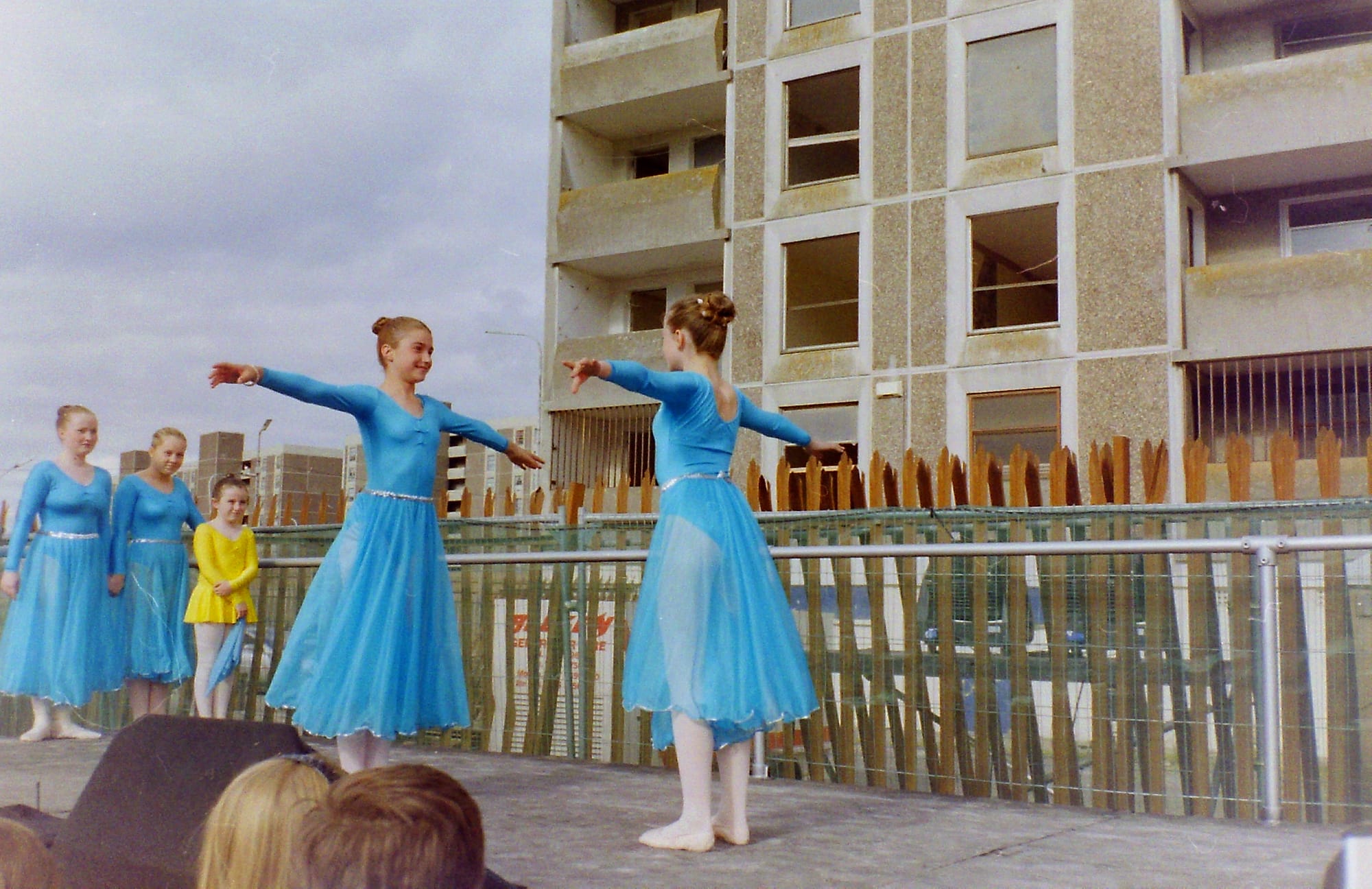What’s the best way to tell area residents about plans for a new asylum shelter nearby?
The government should tell communities directly about plans for new asylum shelters, some activists and politicians say.
A selection of Seamus Kelly’s photographs from a decade of publishing the “Ballymun Concrete News” are on display at Axis: Ballymun until the end of March.

That was a tough one to take, says Seamus Kelly.
The photo he is talking about shows a brightly lit stage with pantomime players in luminous green costumes. Kelly was in the audience with his small camera, waiting for the right moment to take the shot, he recalls.
“All I had was that little camera,” he said. No telescopic lens, and no digital screen to let you know if what you just took. “So, you either have to have skill or luck. A bit of both.”
It’s busy on Monday late morning at the Axis: Ballymun arts centre, where “Concrete People”, an exhibition that features selection of Kelly’s photographs from the Ballymun Concrete News, is on display until the end of March.
It feels like something of a homecoming.
A group of teenagers pass through and pose in front of some of the photos. “They’re photographing themselves with my art . . . in the background. Fantastic. There you are,” said Kelly.
The 28 photos that make up the exhibition are “both memory and quite current”, says Niamh Ni Chonchubhair, a programme manager at Axis: Ballymun.
They’re soft-coloured images of moments in the life of the community.
Kelly set up the Concrete News as a one-page news-sheet, to tell good-news stories about what was going on in local communities. It was distributed to homes in Ballymun, and through libraries in the city, long before hyperlocals became the next big small thing.

He catalogued almost a decade there, from issue one in July 1998 — which was designed on Word, printed off from a floppy disk, and photocopied — through the Concrete News‘s growth to a full-colour eight-page tabloid, to its closure in March 2006, after plans for the shopping centre fell through, and so advertising revenue he’d been counting on failed to arrive.
There are scenes of the filming of Bloody Sunday, a group of kids assembled for a charity toddle-waddle walk, and a high-rise shot of a guy abseiling down Eamonn Ceannt Tower.
“I was very pleased with the result of that,” he said, pointing to the image of a sports-day race, which shows girls at the start-line, tilted into a run.
The photos focus on the people, which was intentional.
Says Ni Chonchubhair: “People think about the bricks and the mortar, but it is the people who made Ballymun what it is. There’s a nostalgia to it, but it’s also quite current.”

Kelly can’t choose a favourite from among his photos.
“To me, all of those photographs represent the Ballymun Concrete News, what it was about,” he says. “Seeing people in a positive light. Each photo has its own significant meaning.”
Some of the stories that Kelly tells make it clear that he was often more than a passive observer.
This is a show he was in, he says – pointing at one image, of a performance that was put on to celebrate the beginning of a new Ballymun.
Who did he play? “The journalist of course,” he says. “The snoopy reporter. Here I was snooping around. I went down on my knee, and I wasn’t actually supposed to use real film, but I said feck it, and I got that shot and I was delighted.”
“Because I was acting, but at the same time I was being myself,” he says.
We walk by another photo, which shows the now-demolished towers. “I lived in Plunkett Tower, so I would have taken this from my own flat,” he said.
He used to take photographs out the window, he said. He points out and names the towers, saying that it was a close-knit community, that everyone experienced the same neglect and apathy.
A woman nods at another of the pictures, which shows a cloud of smoke and dust. “The towers?” she asks.
“This was Thomas McDonagh Tower,” he said. “Do you remember that, beside Axis? And do you remember the day when the dust-cloud . . . when the wind changed direction? And the dust cloud blew towards all the residents?”
Everybody had to run for cover.
“This makes my day, it does,” he says, seeing people coming by.
Closing up the Concrete News was tough, says Kelly. “It was very painful.”
The editions are now archived online so they won’t be lost. At the mention of bringing it back, he looks incredulous. “I’m 72!” he says. “I’m retired.”
Many people have asked if he has one more issue in him. Perhaps a special issue for the 50 years of Ballymun, or for the 1916 celebrations, or the 15 years of the Axis centre?
I get the sense he might be convinced.
For now, though, Axis: Ballymun is using the exhibition as a launch pad to call for submissions for an exhibition later in the year about Ballymun, which will mainly be photography.
It isn’t going to be hard to find art to feature, said Ni Chonchubhair. “There’s quite the pool out there already.”
“Concrete People” by Seamus Kelly runs from 1 February 2016 until 31 March 2016 at the Axis: Ballymun.
Get our latest headlines in one of them, and recommendations for things to do in Dublin in the other.